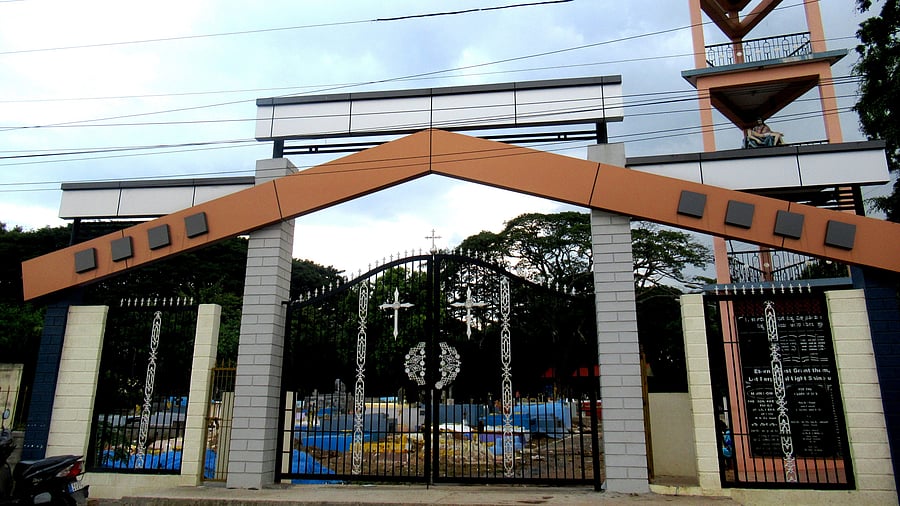
The Gandhinagar Roman Catholic Cemetery in Mysore, where Fr Fraigneau was buried.
Credit: Nemichandra
In 2021, I stumbled upon my father’s long-forgotten manuscript — a translation of James Boswell’s Life of Samuel Johnson into Kannada. Boswell’s book was published in 1791, and my father, Prof G Gundanna, had completed its translation in 1988.
As I opened the hardbound manuscript, my eyes fell on a dedication in English. It read: “This great book is reverently dedicated to the sacred name Rev Fr J B Fraigneau, the late French Professor in St Philomena’s College, Mysore, and Chaplain at St Bridget’s Convent, Nachanahalli Palya, Mysore South.”
I gathered that Fr Fraigneau, a scholar of French, Latin, Greek, and English, had “most lovingly rendered into Kannada the numerous alien language quotations cited in the original.” I began to wonder — who was Fr Fraigneau?
I travelled to Mysuru, and my brother joined me in the search for Fr Fraigneau. It was not hard to find St Bridget’s Convent at Nachanahalli Palya (now called J P Nagar). However, no one at the convent had heard of him.
We went next to the Bishop’s House in the city centre. There, we were asked to contact Rev Dr Bernard Prakash Barnis at St Philomena’s College and were also informed that Fr Fraigneau was buried at the Gandhinagar Roman Catholic cemetery.
Our next stop was the cemetery. We found the levelled tomb in front of a statue of Jesus. The tombstone read: “Rev Fr Fraigneau Julien J B, Born: 10-12-1921, Ordained: 29-6-1946, Died: 19-9-1982.”
It was late evening when we arrived at St Philomena’s College. Rev Dr Prakash Barnis, the Rector, allowed us to sit in his room and go through the college’s annual books from the 1950s to the 1980s.
Fr Fraigneau was born in France in 1921. He was ordained to the priesthood as a member of the Foreign Mission Society in 1946. He held a Master’s degree in pure mathematics from the Sorbonne, a university of repute, where Marie Curie studied. Later, he was sent to England to continue his education in mathematics. He obtained his Licentiate from
Cambridge.
The scholar joined the Diocese of Mysore in 1949 and was appointed as a lecturer at St Philomena’s College.
The college’s principal in 1982, Rev Fr Valerian D’Souza, had written: “Like many a genius, Fr Fraigneau found it difficult to communicate in the classroom, and he decided to move into a parish of the diocese. But he returned to the college as a French lecturer in 1976 and continued to be on the staff until he retired on June 15, 1982. Fr Fraigneau was a versatile genius. His passion was pure mathematics, especially astronomical calculations. He knew most of European languages and half a dozen Indian ones, including Kannada, Hindi, Tamil, Malayalam, Telugu, and Konkani. He had his own typewriter for many of these languages. He loved music and played the organ daily.”
I realised he was an extraordinary scholar who led an austere life. On June 15, 1982, he took up his new assignment as Chaplain to the Bridget’s Convent. Sadly, within months, he passed away on September 19, 1982 at Holdsworth Memorial Hospital, where he had undergone surgery for prostate glands.
I longed to see his face—“pure like a crystal,” as my father had described it. I scanned through the yearbooks but could find no photo. I contacted Othbert Pinto, former director of Postgraduate Studies and Research Centre at the college. “Fr Fraigneau was made the founder-secretary of the Mysore Diocese Educational Society, which was established in 1966. His tenure was from 1966 to 1971. During this period, he was staying at the Bishop’s House,” Othbert Pinto informed me.
When I finally received the photo from Othbert Pinto, I looked at the serene face of Fr Fraigneau. My father had been right in his description: “His snow-white, saintly face with his slight beard resembled exactly that of Christ as we see in the Last Supper.”